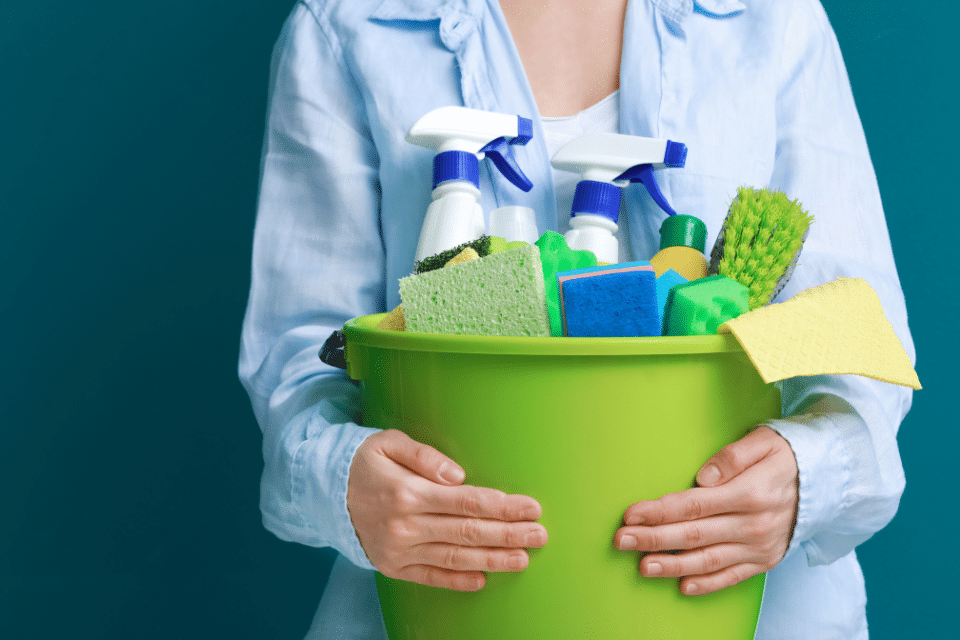Are Your Scented Household Products Toxic?

I’ve written about this before, in my post Are Your Cleaning Products Toxic?. However, my experience this past week inspired me to write about it again. So many household and cleaning products seem to be scented these days. You can’t go to the store to buy something as basic as garbage bags without them being “scented”.
Ironically, as more and more people develop health issues ranging from sensitivities to chemicals, to cancer from contact with unknown environmental toxins—corporations like Proctor & Gamble, and Krogers are scenting everything imaginable. Many fragrances and scents contain phthalates and other carcinogenic or toxic chemicals. Do you use scented household products? Are your scented household products toxic? And how would you know if they were?
Spring Cleaning Mistake
Last week I decided to do a major spring clean of my office. My office building is in a light-industrial area next to a cement truck facility, which makes my office very dusty. I normally clean the wood in my boat using a rag and white vinegar with essential oils. But I have found Swiffers to be a more efficient way to clean my office. Since they are statically charged to attract dust the woven fabric holds the dust better than a rag. So my husband Kirk picked up a box of Swiffers for me when he was at the store, and dropped them off at my office.
When he handed me the box of Swiffers, I immediately smelled a strong scent, and noticed that the box said “Fabreeze scent”. I didn’t realize that Swiffers even came “scented”, and remarked on it. Kirk was surprised that he hadn’t noticed it himself, and he asked if I wanted him to return them. Not wanting to waste his time, and wanting to get cleaning my office I decided to go ahead and use them this one time.
What is in Your Household Cleaning Products?
Within a minute or two, the palm of my hand was burning. (I used the Swiffers as dust cloths, not with one of their intended gadgets, so I was holding it in my hand.) After thoroughly washing my hands and using a paper towel to hold the Swiffer, I finished cleaning my dusty office. I then threw away the rest of the box of Swiffers and emptied the garbage. It was already starting to stink up my whole office! And I left my window wide open all night and went home.
The next morning when I came into work, I was hit by an overpowering noxious smell of “Fabreeze”. I left my door and window open all day to get cross-ventilation. But several hours after being there, my eyes were stinging, my throat was burning. And I had a headache, which I never get. And I had to go home for the day, as I could hardly breathe in my office. WHAT is in that “Fabreeze” anyway? I decided to look up the ingredients on P&G’s website.
Shockingly, they won’t tell you exactly which chemicals are in their products—their list of ingredients for all products is “proprietary”, but they offer a 16-page PDF in a 2-column list, filled with long-named chemical ingredients that I can’t pronounce. Turns out they have over 40 household products that contain the “Fabreeze” scent, including air fresheners, and fabric softeners. I hate to think about what those chemicals would do to your lungs and skin if you use those products on the daily.
Are Your Scented Household Products Toxic?
I decided to do some more research and found the Environmental Working Group’s (EWG) website where they have a guide to healthy cleaning products. EWG* independently tests a wide range of products from personal health and beauty products to household cleaning products. They test for toxic chemicals, carcinogens, chemicals that cause nerve damage, and birth defects, among other things. Are your scented household products toxic? You can look up the products you use on the EWG website. I was not at all surprised to find that of the “Fabreeze” products they tested:
- 2 products rated a “C” (MODERATE CONCERN: Some potential for hazards to health or the environment)
- 24 products scored a “D” (HIGH CONCERN: Likely hazards to health or the environment, poor ingredient disclosure)
- 14 products scored an “F” (HIGHEST CONCERN Potentially significant hazards to health or the environment and poor ingredient disclosure)
DIY Your Household Cleaning Products
I typically never purchase chemically scented products. So this was a valuable lesson for us to be more thorough when reading labels to double-check for fragrances in any household items that we buy. My usual approach is to create our own cleaning solutions using readily available ingredients including white vinegar, baking soda, lemons, and essential oils. And I highly recommend trying out these DIY home-cleaning recipes. However, it’s important to note that vinegar should not be used on marble counters or tiles as it can cause erosion.
*EWG provides information on cleaning product ingredients from the published scientific literature, to supplement incomplete data available from companies and the government. The ratings indicate the relative level of concern posed by exposure to the ingredients in this product – not the product itself – compared to other product formulations. The ratings reflect potential health hazards but do not account for the level of exposure or individual susceptibility, factors that determine actual health risks, if any.
Please leave a message to let us know your biggest takeaway.


Wow! Thanks Heidi. That is great food for thought. We often use products labeled ‘natural’ in our home but I rarely read the label. I also find myself slipping back into habits of purchase that were modeled to me as a kid, like using Windex to clean mirrors and glass. Thanks for the wake up call.
Glad you found it helpful Leslie, it’s sad, but we really need to be diligent with reading labels both of what we are putting IN our bodies as well as ON our bodies.